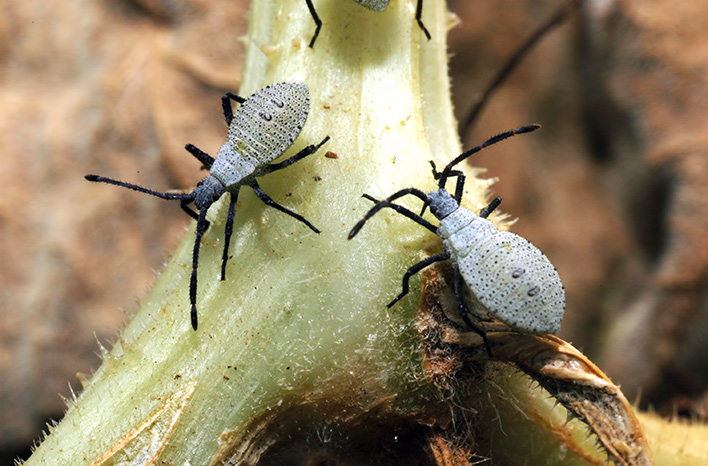Introduction
Zucchini is a popular vegetable among home gardeners due to its versatility and high yield. However, zucchini plants often face challenges from various pests that can damage leaves, stems, and fruits. Understanding what eats zucchini in your garden is crucial for maintaining healthy plants and a bountiful harvest. This article will explore the most common zucchini pests, how to identify their damage, and effective management strategies to protect your garden.
Common Pests That Eat Zucchini in Gardens
1. Squash Bugs
Squash bugs (Anasa tristis) are among the most notorious pests attacking zucchini plants. These brownish, shield-shaped insects suck sap from leaves, causing them to wilt, yellow, and eventually die.
- Identification: Adults are about 5/8 inch long, with flat backs and brownish-gray color. Eggs are bronze and laid beneath leaves.
- Damage Signs: Wilting leaves, yellow spots, and black eggs on undersides of leaves.
- Lifecycle: Eggs hatch in 7-10 days; nymphs feed and mature over several weeks.
2. Cucumber Beetles
Cucumber beetles, especially the striped and spotted varieties, feed voraciously on zucchini.
- Identification: Small beetles (1/4 inch) with yellow-green bodies and black stripes or spots.
- Damage: They chew holes in leaves and also transmit bacterial wilt, a serious disease for zucchini.
- Lifecycle: Adults overwinter in debris and emerge in spring to feed and lay eggs.
3. Vine Borers
Squash vine borers (Melittia cucurbitae) are moth larvae that tunnel into zucchini stems, causing plants to collapse.
- Identification: Adult moths look like wasps; larvae are white with brown heads.
- Damage: Sudden wilting of vines, holes at stem bases with frass (sawdust-like excrement).
- Lifecycle: Eggs laid at stem bases hatch into larvae that burrow inside stems.
4. Slugs and Snails
These mollusks are active at night and feed on zucchini leaves and fruits, leaving irregular holes and slime trails.
- Identification: Slimy trails and irregularly chewed leaves.
- Damage: Holes in leaves and fruit surface scars.
5. Aphids
Aphids are tiny, soft-bodied insects that cluster on the undersides of leaves and stems.
- Identification: Green, black, or gray insects appearing in clusters.
- Damage: They suck plant sap, causing distorted growth and transmitting viruses.
How to Identify Zucchini Pest Damage
Recognizing pest damage early can save your zucchini crop. Here are key signs:
- Wilting and yellowing leaves: Often caused by squash bugs and vine borers.
- Holes in leaves and fruits: Cucumber beetles and slugs/snails are primary culprits.
- Sticky residue and curled leaves: Aphids excrete honeydew, leading to sooty mold.
- Frass and stem holes: Indicative of vine borer activity.
Effective Management and Prevention Tips
Cultural Controls
- Crop rotation: Avoid planting zucchini in the same spot yearly to disrupt pest life cycles.
- Clean garden debris: Remove overwintering sites for pests like cucumber beetles and squash bugs.
- Plant timing: Early planting can help avoid peak pest populations.
Physical Controls
- Handpicking: Remove squash bugs, cucumber beetles, and vine borers manually.
- Row covers: Use lightweight covers to protect young plants from egg-laying adults.
- Slug traps: Beer traps or copper barriers deter slugs and snails.
Biological Controls
- Introduce beneficial insects: Ladybugs and lacewings prey on aphids.
- Nematodes: Beneficial nematodes can reduce vine borer larvae in the soil.
Chemical Controls
- Insecticidal soaps and neem oil: Effective against soft-bodied insects like aphids.
- Targeted pesticides: Use as a last resort, focusing on specific pests and following label instructions carefully.
Real-World Example: Successful Zucchini Pest Management
An Iowa home gardener reported significant squash bug damage. By implementing early-season row covers and regular handpicking, combined with garden hygiene, the gardener reduced pest populations by 70% and improved zucchini yield dramatically.
Conclusion
Knowing what eats zucchini in your garden helps you take proactive steps to protect your plants. Squash bugs, cucumber beetles, vine borers, slugs, and aphids are the primary offenders causing damage. By identifying pest signs early and using integrated pest management techniques—including cultural, physical, biological, and chemical controls—you can safeguard your zucchini crop effectively. Remember, regular monitoring and timely intervention are key to maintaining a healthy garden and enjoying a plentiful zucchini harvest.
